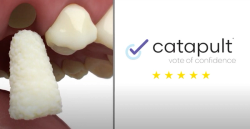- About Us
- Advertise
- Editorial
- Contact Us
- Terms and Conditions
- Privacy Policy
- Do Not Sell My Personal Information
© 2025 MJH Life Sciences™ and Dental Products Report. All rights reserved.
How to: Provide veneers on a budget
In today’s challenging economic climate, more people are experiencing or are at-risk of job loss. Confronted with the growing difficulty of providing basic necessities for themselves and their families, they want every shrinking dollar to count.
In today’s challenging economic climate, more people are experiencing or are at-risk of job loss. Confronted with the growing difficulty of providing basic necessities for themselves and their families, they want every shrinking dollar to count.
While many patients seek cosmetic dental restoration work, these procedures typically aren’t covered by dental insurance, and people may find themselves with more limited financial resources and greater spending restrictions. Yet they still desire-even expect and demand-enhanced esthetics from their dentists. Additionally, patients are concerned about minimally invasive and “reversible” treatments that don’t harm tooth structure.
Weighing the options
To help dentists achieve these patient demands, veneer restorations are well suited for conservative and esthetic enhancement, particularly on anterior dentition. Porcelain veneer restorations provide optimal natural-looking esthetics, are extremely stain-resistant and last for up to 15 years. However, they are expensive at $1,000 to $2,000 per tooth and are a permanent, irreversible solution that may require multiple lengthy office visits for treatment completion, as well as sedation for pain. Additionally, once damaged, porcelain veneers cannot be repaired; they must be replaced.
While there are disadvantages associated with direct composite bonding (e.g., the most technique sensitive dental veneers), the process offers superior control over coloring and contouring for the experienced practitioner, especially on single, anterior dentition. They also are relatively affordable at $350 to $650 per tooth.
Direct/indirect composite resin veneers feature both direct and indirect techniques in reconstruction of restorations with improved physical properties. Current composite materials on the market have enhanced material and optical properties for esthetics and durability. 1-3 Numerous studies examining factors such as marginal integrity, bond strength, adhesive layer thickness, discoloration and shrinkage of restoration also indicate acceptable results for composite resin restorations. 4-8 Additionally, many composites can be applied with little or no preparation of tooth structure.
When esthetic concerns are of utmost importance-such as when restorative work is performed on the upper and lower anterior teeth-dentists can achieve superior esthetics, fit and function by combining direct and indirect techniques. The direct/indirect combined procedure is fast, simple and affordable. The efficient process typically requires just 5-to-7-minutes to complete the mock-up, 5-to-7-minutes to polish, and then 5-to-7-minutes to seat, frequently without the need for an anesthetic. Fractural strength and durability also have been found to be satisfactory 9-11 and clinically acceptable in restorations achieved through a direct/indirect composite method. While composite restorations do demonstrate some degree of degradation (i.e., discoloration, marginal degradation and color mismatching) over time, studies have shown that they provide a relatively stable and effective span of lifetime (i.e., up to 7 years) before requiring touch-ups and/or replacement. 12
Repairing, rather than replacing, the restoration has a significantly lower impact on chairside time and discomfort of the procedure. When weighed against its relatively shorter durability compared to other types of restorations, a direct/indirect combination restoration touch-up still remains the more desirable option to many patients. 13
It’s also worth noting that bleaching may lead to a negative influence (i.e., degradation of physical properties, marginal integrity, color, and enamel and dentin bond strength) on restorations and restorative materials. Rather than bleaching, periodic touch-ups are recommended for maintenance of satisfactory esthetics and function. 14
When maintaining marginal integrity to restore a proper smile line is more of a consideration, the recommended method is the use of adhesive restorations (e.g., primarily direct composite buildups). In cases presenting more extensive tissue loss, discoloration and/or facial morphology, the dentist may suggest veneers and crowns. 15
The direct/indirect composite method, also referred to as semi-direct, is ideally suited and indicated for patients with diastemas.
Making direct composite veneers employing a combination of a direct composite technique with indirect shaping and cementing techniques has been discussed and demonstrated by others,16,17 and isn’t unique to the author. However, this technique article demonstrates how the author has modified the indirect/direct technique to best accommodate his patients’ specific needs.
Case presentation
A college-age female patient presented with diastema. Her before smile depicted post-orthodontic, smaller-size teeth with noticeable gaps between the teeth (Figs. 1 and 2). After a thorough examination of her oral condition and a detailed discussion, it was determined that the patient desired improved esthetic results. However, while at a later date she looked forward to treatment with more comprehensive all-ceramic restorations, at the time, her family budget was limited. In collaborative consultation that took cost into careful account, the author and the patient selected a modified direct/indirect composite resin veneer as the treatment of choice.
Using the IPS Empress Direct Kit composite (Ivoclar Vivadent), the diastema was closed at the midline, and some shape changes were made to the distal of tooth Nos. 8 and 9. In addition, a mock-up was made for tooth Nos. 7 and 10 to achieve a more ideal shape. This was accomplished on a dry tooth without the use of an etch or a bond (Fig. 3). The mock-up was cured (Fig. 4).
After being removed, the mock-up was prepared for chairside adjustments and changes to overall shape (Fig. 5).
The composite restoration that was shaped intraorally was then adjusted, polished and finished outside of the mouth (i.e., indirectly) chairside. Note: At this time, the restoration may be highly polished for optimal smoothness, fit and overall refinement (Fig. 6).
The restoration was then cemented using adhesive with a similar protocol when seating an indirect restoration.
Upon completion, the final smile exhibited superior esthetics. Note the improved arch form and general symmetry. The patient was prescribed a recall visit during her college break for follow-up examination and polish (Figs. 7-10).
Conclusion
In an unrelated case completed in 2006, the patient was so satisfied with the results that in preparation for her upcoming wedding, she returned for follow-up work. In September of 2011, a touch-up of the facial-incisal of tooth No. 9 was completed. (Figs. 11-12). Thanks to the minor additional touch-up, five years later in 2011, the author was able to give his patient the gift of a radiant smile on her wedding day (Fig. 13). The cost of the touch-up may have been economical, but the confidence gained by the patient on her special day when all eyes were on her could be considered priceless.
As this case illustrates, the direct/indirect resin composite veneer approach is an affordable and time-efficient (between 15 and 30 minutes) alternative for economically stressed patients seeking superior esthetic restorations. Dentists can charge a fair fee and patients can be ensured of a conservative and minimally invasive procedure for smile enhancements that exhibit outstanding results.
References
1. Fahl Júnior N. The direct/indirect composite resin veneers: a case report. Pract Periodontics Aesthet Dent. 1996 Sep;8(7):627-38; quiz 640.
2. Dietschi D, Devigus A. Prefabricated composite veneers: historical perspectives, indications and clinical application. Eur J Esthet Dent. 2011 Summer;6(2):178-87.
3. Zorba YO, Bayindir YZ, Barutcugil C. Direct laminate veneers with resin composites: two case reports with five-year follow-ups. J Contemp Dent Pract. 2010 Jul 1;11(4):E056-62.
4. Cox CF, Tarim B, Kopel H, Gürel G, Hafez A. Technique sensitivity: biological factors contributing to clinical success with various restorative materials. Adv Dent Res. 2001 Aug;15:85-90. Review.
5. Heintze SD. Systematic reviews: I. The correlation between laboratory tests on marginal quality and bond strength. II. The correlation between marginal quality and clinical outcome. J Adhes Dent. 2007;9 Suppl 1:77-106. Review Erratum in: J Adhes Dent. 2007 Dec;9(6):546.
6. Pazinatto FB, Atta MT. Influence of differently oriented dentin surfaces and the regional variation of specimens on adhesive layer thickness and bond strength. J Esthet Restor Dent. 2008;20(2):119-28; discussion 129.
7. Heintze SD, Ruffieux C, Rousson V. Clinical performance of cervical presentations-a meta-analysis. Dent Mater. 2010 Oct;26(10):993-1000. Epub 2010 Jul 16.
8. Takahashi H, Finger WJ, Wegner K, Utterodt A, Komatsu M, Wöstmann B, Balkenhol M. Factors influencing marginal cavity adaptation of nanofiller containing resin composite restorations. Dent Mater. 2010 Dec;26(12):1166-75. Epub 2010 Sep 29.
9. Ozcan M, Mese A. Fracture strength of indirect resin composite laminates to teeth with existing restorations: an evaluation of conditioning protocols. J Adhes Dent. 2009 Oct;11(5):391-7.
10. Gresnigt NM, Ozcan M. Fracture strength of direct versus indirect laminates with and without fiber application at the cementation interface. Dent Mater. 2007 Aug;23(8):927-33. Epub 2006 Oct 6.
11. Mendonça JS, Neto RG, Santiago, SL, Lauris JR, Navarro ME, de Carvalho, RM. Direct resin composite restorations versus indirect composite inlays: one-year results. J Contemp Dent Pract. 2010 May 1;11(3):025-32.
12. Gordan VV, Garvan CW, Blaser PK, Mondragon E, Mijör IA. A long-term evaluation of alternative treatments to replacement of resin-based composite restorations: results of a seven-year study. J Am Dent Assoc. 2009 Dec;140(12):1476-84.
13. Sharif MO, Catleugh M, Merry A, Tickle M, Dunne SM, Brunton P, Aggarwal VR. Replacement versus repair of defective restorations in adults: resin composite. Cochrane Database Syst Rev. 2010 Feb 17;(2):CD005971.
14. Attin T, Hannig C, Wiegand A, Attin R. Effect of bleaching on restorative materials and restorations-a systematic review. Dent Mater. 2004 Nov;20(9):852-61.
15. Dietschi D, Argente A. A comprehensive and conservative approach for the restoration of abrasion and erosion. Part II: clinical procedures and case report. Eur J Esthet Dent. 2011 Summer;6(2):142-59.
16. King KA, Powell L. Quick and easy: Indirect fabrication of composite veneers. J Tenn Dent Assoc. 2010 Spring;90(2):32-4; quiz 34-5.
17. Devoto W, Saracinelli M, Manauta J. Composite in everyday practice: how to choose the right material and simplify application techniques in the anterior teeth. Eur J Esthet Dent. 2010 Spring;5(1):102-24



